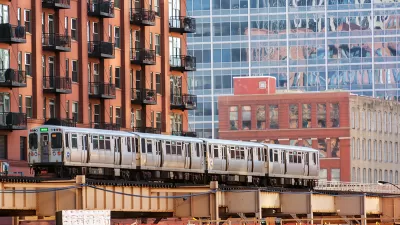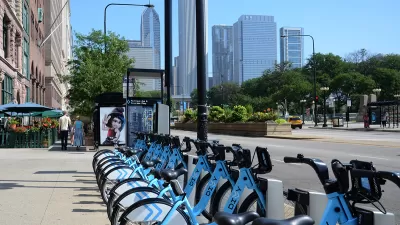Samuel Baron makes the case that Divvy, Chicago's "newest transportation system," should be better integrated with the city's other public transport systems.
While guest blogging for Transitized, Samuel Baron explains how "Chicago’s mobility investments are not being optimized to their full potential due to the silos between Divvy, the CTA, and Ventra, for example:
Here's how Baron describes the current situation: "While traversing the city, I became painfully aware that CTA and Divvy exist in virtual silos. At the moment, it isn’t possible to plan a mixedmode trip itinerary comprised of both CTA and Divvy services. To plan this multimodal trip, one must route the trip manually, switching back and forth between various mobile applications."
And the implications of the silos: "By not connecting the CTA and Divvy network together digitally, the Windy City is failing to capitalize on a monumental opportunity to reconceive how Chicagoans move. Part of the challenge of reducing autodependence and reducing emissions is contending with the flexibility that the automobile offers. With the right technology, mixedmode commuting can replicate the flexibility of the automobile and offer a seamless doortodoor journey."
Baron also provides a few tips on how to achieve integration, as does Transitized editor Shaun Jacobsen in the post's introduction. Jacobsen also chimes in with the following: "There is a new mobile app, RideScout, available that combines public transport directions with Divvy as well as several other transport modes. RideScout was just released for Chicago."
FULL STORY: Guest Post: Do the CTA and Divvy exist in ‘virtual silos’?

Maui's Vacation Rental Debate Turns Ugly
Verbal attacks, misinformation campaigns and fistfights plague a high-stakes debate to convert thousands of vacation rentals into long-term housing.

Planetizen Federal Action Tracker
A weekly monitor of how Trump’s orders and actions are impacting planners and planning in America.

San Francisco Suspends Traffic Calming Amidst Record Deaths
Citing “a challenging fiscal landscape,” the city will cease the program on the heels of 42 traffic deaths, including 24 pedestrians.

Defunct Pittsburgh Power Plant to Become Residential Tower
A decommissioned steam heat plant will be redeveloped into almost 100 affordable housing units.

Trump Prompts Restructuring of Transportation Research Board in “Unprecedented Overreach”
The TRB has eliminated more than half of its committees including those focused on climate, equity, and cities.

Amtrak Rolls Out New Orleans to Alabama “Mardi Gras” Train
The new service will operate morning and evening departures between Mobile and New Orleans.
Urban Design for Planners 1: Software Tools
This six-course series explores essential urban design concepts using open source software and equips planners with the tools they need to participate fully in the urban design process.
Planning for Universal Design
Learn the tools for implementing Universal Design in planning regulations.
Heyer Gruel & Associates PA
JM Goldson LLC
Custer County Colorado
City of Camden Redevelopment Agency
City of Astoria
Transportation Research & Education Center (TREC) at Portland State University
Jefferson Parish Government
Camden Redevelopment Agency
City of Claremont




























